Few important Road Safety Tips are mentioned below :
- Don't use your mobile phone whilst driving
- Belt up in the back
- Don't drink and drive
- Always adhere to speed limits
- Take special care about children, senior citizens and pedestrians.
- Don't drive if tired.
- Pedestrians should walk cautiously.
- Always observe and anticipate other road users.
- Keep your distances.
- Always wear helmets and seat belts
The rules enlisted under this category are to be meant for all the people sharing the roads. The idea behind formulating such rules is that the roads are meant not only for the drivers (including motorists/cyclists/motorcyclists), but are shared by the pedestrians and animals by the road side.
The rules belonging to these categories are mandatory to be followed while using the roads. You can observe all the above-stated rules only if you are patient, considerate and careful..
A traffic light, traffic signal or a stop light is a signaling device positioned at a road intersection to indicate when it is safe to wade through. The traffic signal passes on its information using a universal color code
 |  |  |
STOP & WAIT | GET READY | GO |
Road Signals
Signs form a vital and integral part of the trafficking system for the safety of the road users. As per IRC (Indian Roads Congress) Road Signs are for indications on the road the road signs are categorized into 3 types:
Mandatory Signs or Regulatory Signs
 |  |  |  |
Straight Prohibited or No Entry | One Way Sign | One Way Sign | Vehicle Prohibited in Both Directions |
 |  |  |  |
| All Motor Vehicles Prohibited | Truck Prohibited | Bullock Cart Prohibited | Tonga Prohibited |
 |  |  |  |
| Hand Cart Prohibited | Cycle Prohibited | Pedestrians Prohibited | Right turn Prohibited |
 |  |  |  |
| Left Tturn Prohibited | U-Turn Prohibited | Overtaking Prohibited | Horn Prohibited |
 |  |  |  |
| Bullock Cart & Cart Prohibited | Length Limit | Speed Limit | Load Limit |
 |  |  |  |
| Height Limit | Width Limit | Axle Load Limit | Restriction Ends Sign |
 |  |  |  |
| No Parking | No Stopping or Standing | Compulsory Ahead Only | Compulsory Keep Left |
 |  |  |  |
| Compulsory Turn Left | Compulsory Tturn Right | Compulsory Turn Right Ahead | Compulsory Turn Left Ahead |
 |  |  |  |
| Compulsory Ahead or Turn Left | Compulsory Ahead or Turn Right | Compulsory Cycle Track | Compulsory Sound Horn |
 |  | ||
| Stop | Give Way | ||
Cautionary Signs or Warning or Precautionary
 |  |  |  |  |
Right Hand Curve | Left Hand Curve | Right Hair Pin Bend | Left Hair Pin Bend | Right Reverse Bend |
 |  |  |  |  |
| Left Reverse Bend | Steep Ascent | Steep Descent | Narrow Road Ahead | Road Wideness Ahead |
 |  |  |  |  |
| Narrow Bridge | Slippery Road | Loose Gravel | Cycle Crossing | Pedestrian Crossing |
 |  |  |  |  |
| School Ahead | Men at Work | Cattle | Falling Rocks | Ferry |
 |  |  |  |  |
| Cross Road | Gap in Median | Side Road Right | Side Road Left | Y-Intersection |
 |  |  |  |  |
| Y-Intersection | Y-Intersection | T-Intersection | Staggered Intersection | Staggered Intersection |
 |  |  |  |  |
| Major Road Ahead | Major Road Ahead | Roundabout | Dangerous Dip | Hump or Rough Road |
 |  |  |  |  |
| Barrier Ahead | 200 Meters | 50-100 Meters | 200 Meters | 50-100 Meters |
Informatory Signs
 |  |
Advanced Direction Sign | Re-Assurance Sign |
 |  |
| Destination Sign | Place Identification Sign |
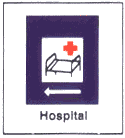 |  |
| Hospital | First Aid Post |
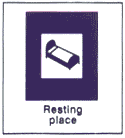 |  |
| Resting Place | Eating Place |
 |  |
| No Through Road | No Through Side Road |
 |  |
| Park This Side | Park This Both Side |
 |  |
| Parking Lot Taxis | Parking Lot Auto rickshaws |
 |  |
| Parking Lot Cycle rickshaws | Parking Lot Cycles |
 |  |
| Parking Lot Scooters and Motorcycle | Barrier Ahead |
Hand Signals or Manual Regulation Signs are the gestures used to regulate traffic on the road using the hand movements. Traffic policemen use these actions to Regulate traffic particularly at intersections while the drivers use these signals to Notify the other users on the road about his intentions. Based on the person these Can be categorized as:
Hand Signals by Policeman
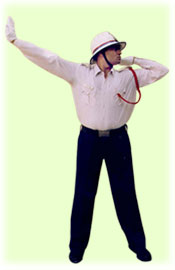 |  |
To start one sided vehicles | To stop vehicles coming from front |
 |  |
| To stop vehicles approaching from behind | To stop vehicles approaching simultaneously from front and behind |
 |  |
| To stop vehicles approaching simultaneously from right and left | To start vehicle approaching from left |
 |  |
| To start vehicles coming from right | To change sign |
 |  |
| To start one sided vehicles | To start vehicles on T-Point |
 |  |
| To give VIP salute | To manage vehicles on T-Point |
I intend to move in to the left or turn left | 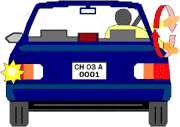 |
I intend to move out to the right or changing the lane or turn right |  |
I intend to stop |  |
I intend to slow down | 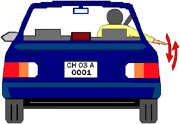 |
Indicating the car following you to overtake |  |
Road markings or pavement markings were introduced in 1920s. Initially, they were used to indicate the road's centerline. But, as they traffic increased, so did the roads and the lanes and later with the multi lane roads they were used to define lanes. With the times, they too have evolved a lot adorned with the information to aid motorists in passing safely.
Centre Line Marking For A Two Lane Road |  |
Lane Line And Broken Centre Line |  |
Centre Barrier Line Marking For A Four Lane Road |  |
Centre Barrier Line Marking For A Six Lane Road |  |
Double White/Yellow Lines: Used where visibility is restricted in both directions. Neither stream of traffic is allowed to cross the lines. |  |
Combination Of Solid And Broken Lines:
|  |
Stop Line: A stop line is a single solid transverse line painted before the intersecting edge of the road junction/ intersection.This line indicates where you are required to stop when directed by traffic officer, traffic light of stop sign. Where a pedestrian crossing is provided, the stop line is marked before the pedestrian crossing. |  |
Give Way Line: The give way line is usually a double dotted line marked transversely at junctions. These lines are generally supplemented by a reverse triangle give way sign painted on the road surface before the dotted lines or by a road sign installed beside the marking. Give way to traffic on the main approaching road. |  |
| Border or Edge Lines: These are continuous lines at the edge of the carriageway and mark the limits of the main carriageway upto which a driver can safely venture. |  |
| Parking Prohibited Lines: A solid continuous yellow line painted on the kerb or edge of the carriageway along with a "No-parking" sign indicates the extent of no-parking area. |  |
| Yellow Box Junctions or Keep Clear: These are yellow crossed diagonal lines within the box. The vehicles should cross it only if they have a clear space available ahead of the yellow box. In this marked area vehicles must not stop even briefly. |  |
Pedestrian Crossings These are alternate black and white stripes painted parallel to the road generally known as zebra crossing. Pedestrians must cross only at the point where these lines are provided and when the signal is in their favour at controlled crossings.You must stop and give way to pedestrians at these crossings. Pedestrian crossings are marked to facilitate and give the right of way to pedestrians. |  |







0 comments:
Post a Comment